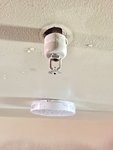

On the morning of Aug. 27, Clark County Fire and Rescue responded to Casa De San Juan Diego Apartments in Woodland for a kitchen fire.
According to the department, the apartment’s occupant had began preparing food on the stove before falling asleep. Damage was confined to the stove and cabinetry and no one in the complex was injured or displaced.
The key to what makes this case different than your average residential fire? A sprinkler system.
Although commonly associated with commercial and industrial spaces, residential sprinklers are a viable option for fire protection. CCF&R Public Information Officer Tim Dawdy said the systems have been around for some time, but have recently become cheaper, making it a more cost-effective solution to home preservation.
Dawdy also mentioned another case of sprinklers saving the day. There was an incident in Battle Ground where a boy about five years old got a hold of a lighter in a closet in one of the apartments. When the boy lit the device it managed to catch along the wall of the closet.
A sprinkler head in the closet went off, leaving responders with a soaking wet child as opposed to a dead one, Dawdy said.
Though the expense was once a deterrent, dropping costs have melted that obstacle. The most recent data from the National Fire Prevention Association had the median price for a residential installation at about $1.22 per square foot in 2013, down from $1.42 in 2008.
Dawdy’s own experience was slightly higher as a 2,200-square-foot residence had a cost of about $4,000, he said.
Depending on where one lives, a fire sprinkler system can take a few forms. Those with residences hooked up to municipal water utilities can have their system utilize the existing plumbing, relying on the pressure already in the system to provide its work.
Out in more rural areas, well water won’t cut it by itself, Dawdy said, requiring the need for a pressurized tank.
Although it is a project costing thousands, Dawdy said the project costs less than what it would to redo the carpeting in a house or high-end accessories such as granite countertops. Having a sprinkler system can also impact insurance rates as the added protection looks good to insurers, saving money in the long run.
Like dealing with any other contractor, Dawdy stressed shopping around, getting several different bids.
“I found that when they bid for my house, they were all over the board,” Dawdy said about the estimates.
Although county or statewide there isn’t any requirement for residential sprinkler systems in homes, municipalities can set their own building guidelines.
Dawdy spoke specifically about Ridgefield, where on flag lots (parcels where residences are connected to the street via a long driveway) or properties with a private bridge, construction requires the systems in the residence due to the difficulty for access.
Dawdy said there were a few misconceptions regarding sprinkler systems. The popular image of a whole floor of sprinklers going off at once is not the case — each sprinkler head has its own fuse that breaks and starts the flow with sufficient heat.
Another misconception is regarded water damage. Although things will get wet when the system goes off, having that immediate mitigation can make all the difference.
“Remember, someone has to discover the fire; someone has to report it via 911 … then we have to drive there and that takes us five minutes,” Dawdy said. “Best-case scenario we’re looking at six minutes to get the first drop of water on that fire.”
“The five or six-minute head start that fire would have had, it would have been deadly, and it also would have impacted the people on all sides of the apartment,” Dawdy said.
What’s more, fire department equipment can cause damage of its own. Dawdy said fire hoses can put out 150 to 250 gallons of water per minute, whereas a sprinkler is more in the realm of 12-18 gallons per minute, meaning less water to clean up afterward.
Even though the sprinklers are far less dramatic than having firefighters on the scene, their impact was on display in Woodland last month, showing that they can be just as effective, if not better.
“A single sprinkler head extinguished the fire (and) very likely saved the building, saved the guy’s life,” Dawdy said.